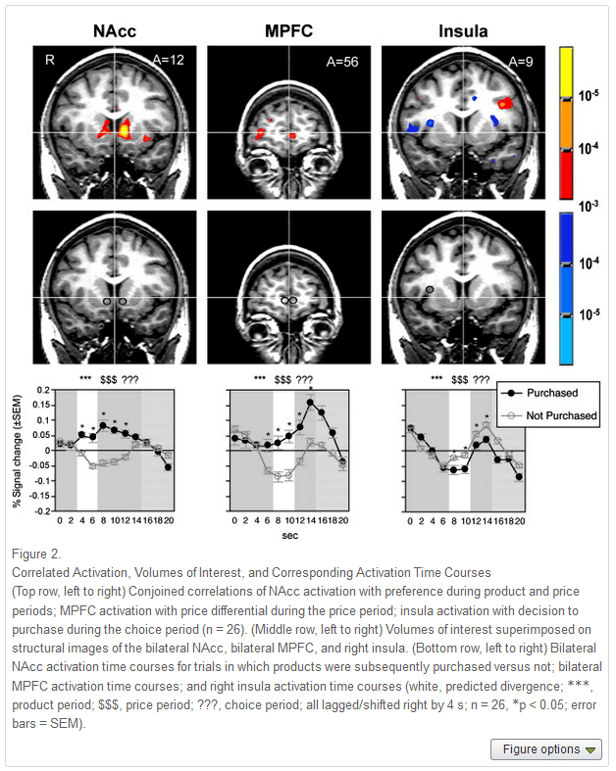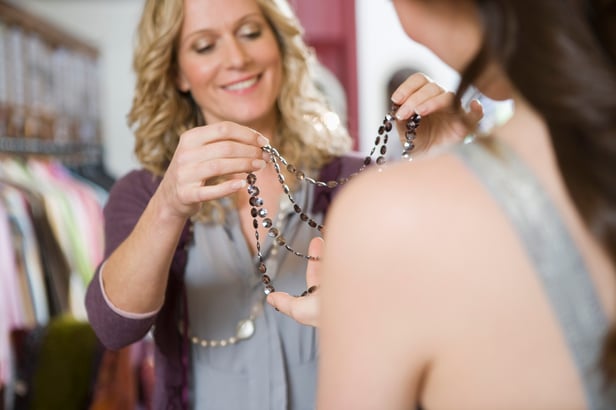It's possible that researchers at Carnegie Mellon have gotten a little carried away with their analysis of sales psychology. They took brain scans while people were shopping and found out that when they decide to buy, their "insular cortex" activates:

Good to know, but how do you use it on your showroom floor?
Well, as far as they can tell, the insular cortex contributes to emotion, self-awareness, and interpersonal experience -- in other words, every critical aspect of a specialty retail sale.
Of course, there's no sure-fire way to light it up. But you can come close with some pretty clever sales techniques that might be worth considering before this holiday season.
First, the Set-Up
The mind conceives of purchases in context. If you don't control the context, then the mind will come up with one on its own -- and that's not the sort of variable you want to leave to chance.
Your showroom and your salesperson establish context, and ideally they will combine to create an exclusive feeling for your customer.
People looking at premium items want to feel like part of an exclusive group. Entering your store should give them that feeling, and your salespeople should groom it. Emotion controls eighty percent of the buying decision, and it's all about the unspoken emotion of being among the elite.

Sticking with emotion means avoiding logic. That means every time you force your customer to make a decision, you risk losing them. Making a decision requires thought and it implies change, which most people fear. Price also threatens to trigger logic, as does ticking off lists of features.So experts coach salespeople to start selling long before getting to price and features.
For specialty retailers, the sale really begins with the layout of your showroom.
Studies suggest that prominently displaying your most expensive items creates "anchors," and that your customers will compare everything else in your store to the anchors. If the anchors are high priced, then everything else looks like a bargain.
However, a binary, high-price / low-price division can cost you sales.
One fascinating study found that when people could purchase two types of beer, one regular and one premium, four out of five bought the premium.
That meant one out of five bought the cheap one, and in an effort to appeal to that segment, researchers added a third beer that was even cheaper than the regular.
The impact on revenue was devastating. No one bought the cheapest beer. Instead, four out of five bought the mid-priced beer, and premium sales evaporated. They speculated that trying to appeal to the low-end was a waste of time.
They hit the jackpot with their third experiment. This time, they dropped the cheapest beer off the list, kept the regular and premium, and added a high-end beer that was more expensive than the premium.
This time around the buyers behaved themselves. More than four out of five still bought the mid-priced beer -- but now that was the premium beer, so adding a more expensive item at the top increased sales of the next highest-priced item.
Even better, one out of ten buyers moved up and bought the high-end beer, creating a entirely new category of high-end sales.
For a specialty retailer, all of this has to be set up before your customer even arrives. By prominently displaying your most expensive items and having slightly less expensive competing items nearby, you make the second-tier prices seem like bargains. If you add a competing item at the third-tier price, you can expect to increase sales of both the mid-tier and top-tier items. In fact, the researchers found that setting a minimum price makes people nearly twice as likely to buy.
The way you display the price matters, too. First of all, it should end in 9. This trick is so ancient a lot of retailers assume it couldn't possibly work anymore, but the research proves that it still does. To a shopper, "$649" is less than "$640" -- always has been, still is, and no one knows why.
Here's a new twist in the same vein: believe it or not, "$1,499.00" is a lot more expensive than "$1499."
Researchers think it's because of the way people read the numbers in their head. The first one, "one thousand four hundred ninety-nine dollars and no cents" takes a long time to think, and in that time her rational mind might wonder if she should be spending that much.
The second one, however, seems manageable: "Fourteen ninety-nine! What a value!"
All of this preparation means you've masterfully hijacked your customer's insular cortex. You controlled the context it will use to understand the price of your merchandise. You've directed it to the premium or high-end options.
And you did this without asking it to make a single conscious decision.
Then, the Performance
Now it's up to your salesperson to make the emotional connection that can close the sale. Still avoiding price and features, experts agree that the focus ought to be on benefits. For most specialty retailers this will have something to do with how your buyer will feel when she has the item in her home.
That's also the number one advantage you have over online retailers, so dwell upon it: your buyer will get the instant gratification of taking the item right now and seeing it in her home today.
Trick her insular cortex into thinking that instant gratification is especially important by surprising her with a small unexpected gift. The value of the gift doesn't matter; one study found that something worth as little as a dime created a positive response.
Food works especially well, mostly because it unquestionably registers in her mind. Handing her a nice logo-emblazoned coaster or something will certainly have an impact, but giving her a few chocolate-covered espresso beans assures that she'll spend quality time with your gift.
 Her insular cortex will feel a need to reciprocate. Since you gave her something, she feels that she wants to do something for you.
Her insular cortex will feel a need to reciprocate. Since you gave her something, she feels that she wants to do something for you.
Staying in the "instant" time-frame, you might expect a conversation in return. This is where the real salesmanship begins, and where you need to control the urge to pour out features and information. Slow down, the experts coach. Your customer will understand you much better if you dole out one little benefit at a time, waiting for a response after each one.
Finally, the Close
Over the course of your conversation you'll watch 80% of your customers gravitate to the mid-priced item while 10% will want the high-priced one. This is the proper moment to gauge your customer's price sensitivity. If she's going for the high-end item and has already decided its a value, say nothing and conclude the sale happily.
But if she's waffling and you can tell that she's uncertain about financing the item on her credit card, most specialty retailers have only two things to suggest: rent-to-own or layaway. Neither of those are actual closes, as you know, because so often those "sales" end up returned. And they're risky because the returned, used, or out-of-style merchandise may not enable you to capture the revenue you would have from a full-price sale.
Thankfully, you're not like most retailers. You have a third option.
It's sort of like another unexpected gift. You can let her write a series of checks to be deposited over time, matching her payments to her cash flow. There's no credit check, its not financing, and you are not exposed to any risk if one of those checks -- even the last one -- is returned. We've been serving specialty retailers like you for thirty-two years, and our clients love this service so much they named it. They call it "in-home layaway." Let it make your fall the best season you've had in years!


